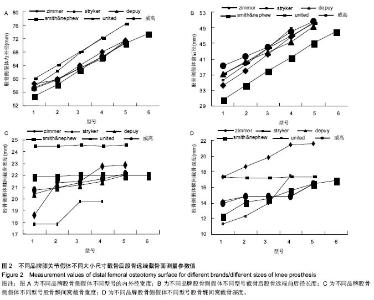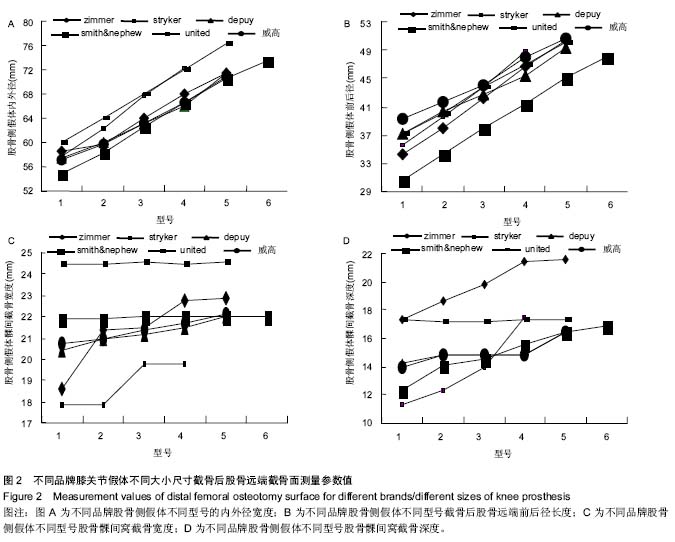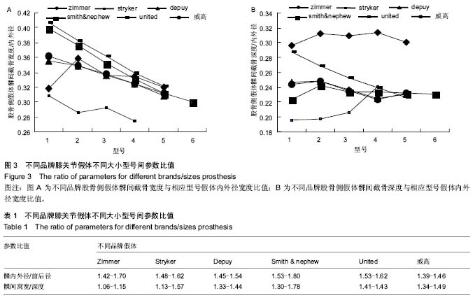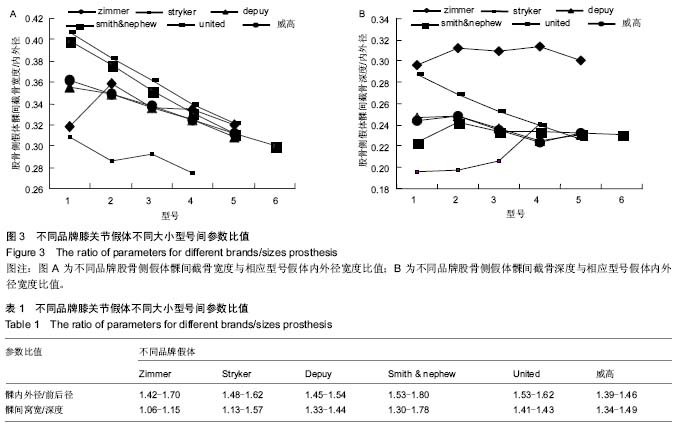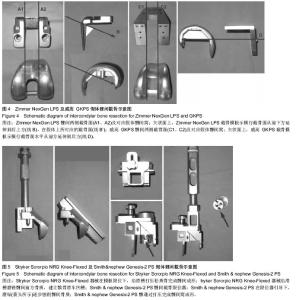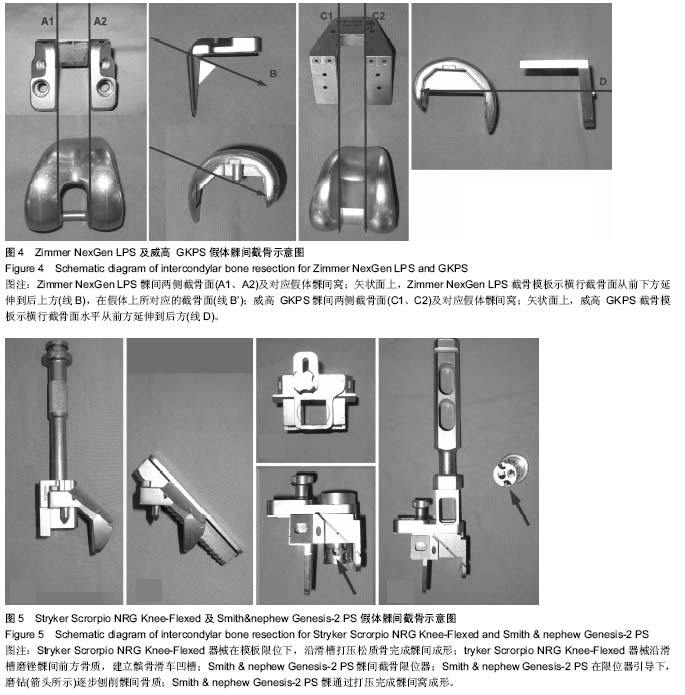| [1] 张锐,柳海平,谢兴文,等.全膝关节置换治疗膝关节外翻畸形[J].中国组织工程研究,2014,18(9):1343-1349.
[2] 李广伟,王红军,孙晓智.全膝关节置换治疗严重膝关节疾病[J]. 中国组织工程研究,2014,17(9):1535-1542.
[3] Dalury DF, Mason JB, Murphy JA, et al. Analysis of the outcome in male and female patients using a unisex total knee replacement system. J Bone Joint Surg Br. 2009;91: 357-360.
[4] Xie F, Lo NN, Pullenayegum EM, et al. Evaluation of health outcomes in osteoarthritis patients after total knee replacement: a two-year follow up. Health Quality Life Outcomes. 2010;8: 87.
[5] Ritter MA, Wing JT, Berend ME, et al. The clinical effect of gender on outcome of total knee arthroplasty. Arthroplasty. 2008; 23: 331-336.
[6] Kurtz S, Ong K, Lau E, et al. Projections of primary and revision hip and knee arthroplasty in the United States from 2005 to 2030. J Bone Joint Surg Am. 2007;4:780-785.
[7] Shen C, Lichstein PM, Austin MS, et al. Revision knee arthroplasty for bone loss: choosing the right degree of constraint. J Arthroplasty. 2014;29(1):127-131.
[8] Vasarhelyi EM, MacDonald SJ, Della Valle CJ, et al. Let's do a revision total knee arthroplasty. Instr Course Lect. 2014;63: 239-251.
[9] Panegrossi G, Ceretti M, Papalia M, et al. Bone loss management in total knee revision surgery. Int Orthop. 2014; 38(2):419-427.
[10] Daines BK, Dennis DA. Management of bone defects in revision total knee arthroplasty. Instr Course Lect. 2013;62:341-348.
[11] Huten D. Femorotibial bone loss during revision total knee arthroplasty. Orthop Traumatol Surg Res. 2013;99(1 Suppl): S22-33.
[12] Qiu YY, Yan CH, Chiu KY, et al. Treatments for bone loss in revision total knee arthroplasty. J Orthop Surg (Hong Kong). 2012;20(1):78-86.
[13] 赵奇,蒋垚.人工膝关节假体设计新进展[J].中国组织工程研究, 2010,14(52):9838-9840.
[14] Matthews J, Chong A, McQueen D, et al.Flexion-extension gap in cruciate-retaining versus posterior-stabilized total knee arthroplasty: a cadaveric study. J Orthop Res. 2014;32(5): 627-632.
[15] Cankaya D, Ozkurt B, Aydin C, et al. No difference in blood loss between posterior-cruciate-ligament-retaining and posterior-cruciate-ligament-stabilized total knee arthroplasties. Knee Surg Sports Traumatol Arthrosc. 2014;22(8):1865-1869.
[16] Ang CL, Fook S, Chia SL,et al.Unconstrained arthroplasty in type II valgus knees: posterior stabilized or cruciate retaining? Knee Surg Sports Traumatol Arthrosc. 2014;22(3):666-673.
[17] Oka S, Matsumoto T, Muratsu H, et al.The influence of the tibial slope on intra-operative soft tissue balance in cruciate-retaining and posterior-stabilized total knee arthroplasty. Knee Surg Sports Traumatol Arthrosc. 2014;22(8):1812-1818.
[18] Wünschel M, Leasure JM, Dalheimer P, et al.Differences in knee joint kinematics and forces after posterior cruciate retaining and stabilized total knee arthroplasty. Knee. 2013;20(6):416-421.
[19] Bercik MJ, Joshi A, Parvizi J. Posterior cruciate-retaining versus posterior-stabilized total knee arthroplasty: a meta-analysis. J Arthroplasty. 2013;28(3):439-444.
[20] Li N, Tan Y, Deng Y, et al.Posterior cruciate-retaining versus posterior stabilized total knee arthroplasty: a meta-analysis of randomized controlled trials. Knee Surg Sports Traumatol Arthrosc. 2014;22(3):556-564.
[21] Matsumoto T, Muratsu H, Kubo S, et al. Intraoperative soft tissue balance reflects minimum 5-year midterm outcomes in cruciate-retaining and posterior-stabilized total knee arthroplasty. J Arthroplasty. 2012;27(9):1723-1730.
[22] Abdel MP, Morrey ME, Jensen MR, et al. Increased long-term survival of posterior cruciate-retaining versus posterior cruciate-stabilizing total knee replacements. J Bone Joint Surg Am. 2011;22:2072-2078.
[23] Agarwal S, Sharma RK, Jain JK. Periprosthetic fractures after total knee arthroplasty. J Orthop Surg (Hong Kong). 2014; 22(1):24-29.
[24] Jassim SS, McNamara I, Hopgood P. Distal femoral replacement in periprosthetic fracture around total knee arthroplasty. Injury. 2014;45(3):550-553.
[25] 朱兴阳,苏海涛,黄永明.全膝关节置换后股骨假体周围的骨折[J]. 中国组织工程研究,2013,17(39):6887-6895.
[26] Della Rocca GJ.Periprosthetic fractures about the knee - an overview.J Knee Surg. 2013;26(1):3-7.
[27] Sarmah SS, Patel S, Reading G, et al. Periprosthetic fractures around total knee arthroplasty. Ann R Coll Surg Engl. 2012; 94(5):302-307.
[28] Lombardi Jr AV, Mallory TH, Waterninan RA. Intereondylar distal femoral fraeture. An unreported complieation of posterior-stabilized total knee arthroplasty. J Arthroplasty. 1995;10:643-650.
[29] 张小春,刘晋闽.全膝关节置换术后假体周围骨折的病因及治疗进展[J].中国中医急症,2015,24(5):844-846.
[30] Kolb K, Koller H, Lorenz I, et al. Operative treatment of distal femoral fractures above total knee arthroplasty with the indirect reduction technique: a long-term follow-up. Injury. 2009; 40:433-439.
[31] 李小娟.人工全膝关节置换术后并发股骨髁间骨折1例临床护理[J].齐鲁护理杂志,2009,15(24):81-82.
[32] 孙剑,向川,卫小春.髋膝关节置换围术期骨质丢失的研究现状及防治[J].上海医学,2011,34(9):708-711.
[33] 何方生,吴兵,盛文辉,等.不同股骨髁间截骨膝关节假体在膝关节置换术中的应用[J].中国矫形外科杂志,2014,22(5):408-414.
[34] 李杨,察宏,张克.膝关节置换术前患者及家属关注问题调查[J].中国骨与关节杂志,2013,2(8):425-430.
[35] Shahi A, Saleh UH, Tan TL, et al. A Unique Pattern of Peri-Prosthetic Fracture Following Total Knee Arthroplasty: The Insufficiency Fracture. J Arthroplasty. 2015;30(6): 1054-1057.
[36] Thukral R, Marya S, Singh C. Management of distal femoral periprosthetic fractures by distal femoral locking plate: A retrospective study. Indian J Orthop. 2015;49(2):199-207.
[37] 沈奕,李晓淼,丁裕润,等.全膝关节置换术后股骨假体周围骨折:附18例报告[J].中国临床医学,2014,21(6):689-691.
[38] McGraw P, Kumar A. Periprosthetic fractures of the femur after total knee arthroplasty. J Orthopaed Traumatol. 2010;11: 135-141.
[39] Kim KI, Egol KA, Hozack WJ, et al. Periprosthetic fractures after total knee arthroplasties. Clin Orthop Relat Res. 2006; 446:167-175.
[40] Gebhard JS, Kilgus DJ. Dislocation of a posterior stabilized total knee prosthesis. A report of two cases. Clin Orthop Relat Res.1990;(254):225-229.
[41] Struelens B, Claes S, Bellemans J. Spacer-related problems in two-stage revision knee arthroplasty. Acta Orthop Belg. 2013;79(4):422-426. |
